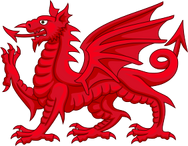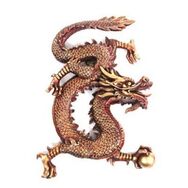Dragons are powerful, mythical creatures, typically depicted as gigantic, flying serpents or other reptiles with magical, spiritual or supernatural qualities. Most dragons are distinguished between the winged Western dragons (derived from various European folk traditions) or Eastern dragons (derived from the Chinese "lóng" dragon).
Dragons occur in many legends around the world. Like most other mythological creatures, dragons are perceived in different ways by different cultures. However, dragons have often held to have major, spiritual significance in various religions and cultures.
The varying stories about dragons from different cultures have been grouped together under the dragon label.
Etymology
The word "dragon" derives from Greek δράκων (drakōn), "a serpent of huge size, a sea serpent or sea fish, a python," and that from the verb δέρκομαι (derkomai) "to see clearly," which may be a reference to the creature having a deadly glance[1][2][3].
Western Dragons

Welsh Dragon
Appearance
Western, or European dragons are depicted as large reptiles that often possess bat-like wings[4][5]. In early European literature dragons can have a variable number of legs: none, two, four, or more[6]. Modern depictions of dragons tend to be larger than their original representations, which were often smaller than humans, and are generally considered to have four legs.
Behavior
They often make their home on cliffs or in deep caverns[7]. They are often seen as evil, dangerous beasts that bring death and destruction, and are often associated with the Devil[8][9][10]. They are proud but often lazy and greedy creatures in myth that love gold and other valuables. They were known for capturing and eating humans, especially young maidens[11]. Heroes often go to slay these monsters, usually to rescue a captive, steal valuables, or obtain glory[12].
Abilities
Western dragons are often depicted with an elemental ability to breath or belch fire from their mouths[13][14][15]. In more modern depictions Western dragons may breathe different things, like poison, or ice.
Symbolism
They were often used in tales about heroes, but were also frequently used as emblems and for heraldry as symbols of power and nobility. Various countries in Europe use dragons as logos and symbols in their flags such as Wales' flag which sports a red four-legged dragon[16].
See: Western dragons
Eastern Dragons

A Chinese Dragon
Appearance
Dragons from the east are more snake-like and generally do not have wings as compared to the European variety. However, whether or not they have wings, they are considered fast and majestic fliers. Many are portrayed with dorsal spines or manes. Eastern dragons are also depicted in varying shapes, colors, and sizes, with some similar to the fairies of other cultures, though red and golden coloration is commonly depicted.
Behavior
These Lóng (sometimes rồng) dragons are generally portrayed as benevolent and wise beings who share their knowledge and bloodline with humans, though there are exceptions[17].
Abilities
Eastern dragons are commonly said to possess some form of magic or other supernatural power or powers, and are often associated with wells, rain, and rivers[18][19]. They are associated with wisdom and often said to be wiser than humans[20]. In addition they are said to possess extreme longevity, living for hundreds or thousands of years. In some cultures, they are also said to be capable of human speech, or even the capability to speak all languages.
Symbolism
In many East Asian cultures dragons were, and in some cultures still are, revered as representative of the primal forces of nature, religion, and the universe[21].
Eastern Dragons by Culture
- In Chinese mythology, the dragon are usually perceived as signs of good luck, and ancient emperors would often claim connections to these almost holy creatures. Their power and knowledge can also be determined by the number of fingers on their claws - for example, the greatest of dragons was said to have 5 claws, and only the Chinese emperor could wear the Dragon Robes decorated with such a creature[22]. Chinese citizens use dragon disguises in various celebrations, most notably when celebrating the Chinese New Year[23].
- In Japanese mythology, belief in dragons is derived from Chinese influence. Like Chinese dragons, Japanese dragons are mainly viewed as wise and divine. In Japan the dragon is used in the Golden Dragon Parade and Festival in Tokyo every March and October 18th. In addition to the more typical eastern-style dragon, there are a few draconic monsters in Japanese culture that more closely resemble western lore.
- In Vietnamese Mythology, rồng dragons play a crucial role in their creation myth. The Vietnamese people are descended from a dragon and a fairy according to this ancient myth. Vietnamese believe the dragons brings rain, which is essential for agriculture. It also represents the emperor, the prosperity and power of the nation, and Yang (male and creative and associated with heaven, heat, and light).
See: Eastern dragons
Draconic Creatures in Other Mythologies and Cultures
- In Catalonian (Spain) Mythology, Catalan Dragons are depicted as serpent-like creatures, with two or four legs. Female Catalan dragons are named víbria. Their breath is poisonous, said to be capable to rot anything or anyone it touches.
- In French Mythology, dragons are referred to as dragoons.
- In Sardinian (Italian) Mythology, a dragon named Scultone is mentioned. This dragon had the power to kill humans with his gaze, is said it was immortal, resided in rural, undeveloped land or country areas.
- In Norse Mythology, there was the serpent-like Lindworms with either a single pair of arms or legs but not both. Dragon heads often adorned Viking longboats in order to strike fear into the hearts of their enemies on raids.
- In Greek Mythology, dragons were frequently guardians of divine locations and objects. In Homer's Iliad, Agamemnon is described as having a blue-colored dragon motif on his sword belt and a three-headed dragon emblem on his breastplate.
- In Egyptian Mythology, a giant serpent known as Apep/Apophis was a divine being and the mortal enemy of Ra, could be considered to be on the same level of power as a dragon.
- In Hindu Mythology (especially Indonesian and Malay), draconic serpents known as Nagas (or Nogos) are considered divine neutral creatures who are usually benevolent in nature. They are commonly equated with and depicted as cobras.
In Popular Culture
Literature
Dragons have been present in literature for thousands of years and even up to today's era. English literature has brought significant change in the world's culture, with novels such as J.R.R. Tolkien's The Hobbit which featured Smaug, a large dragon, as one of its antagonists.
- A gigantic and powerful European dragon named Smaug appears as the main antagonist of J.R.R. Tolkien's The Hobbit[24].
- Indonesian dragons appear in Monsterology: The Complete Book of Fabulous Beasts.
- In A Song of Ice and Fire: A Game of Thrones, a major plot point for Daenerys Targaryen is when she hatches 3 baby dragons and names them Drogon, Viserion, and Rhaegal.
Gallery
References
- ↑ https://www.etymonline.com/word/dragon
- ↑ https://www.britannica.com/topic/dragon-mythological-creature
- ↑ https://www.newworldencyclopedia.org/entry/Dragon
- ↑ https://www.britannica.com/topic/dragon-mythological-creature
- ↑ https://www.newworldencyclopedia.org/entry/Dragon
- ↑ https://www.amnh.org/exhibitions/mythic-creatures/dragons/european-dragons
- ↑ https://www.amnh.org/exhibitions/mythic-creatures/dragons/european-dragons
- ↑ Giants, Monsters, and Dragons: An Encyclopedia of Folklore, Legend, and Myth, By Carol Rose (2001)
- ↑ https://www.newworldencyclopedia.org/entry/Dragon
- ↑ https://www.amnh.org/exhibitions/mythic-creatures/dragons/european-dragons
- ↑ https://www.amnh.org/exhibitions/mythic-creatures/dragons/european-dragons
- ↑ https://www.amnh.org/exhibitions/mythic-creatures/dragons/european-dragons
- ↑ https://www.britannica.com/topic/dragon-mythological-creature
- ↑ https://www.newworldencyclopedia.org/entry/Dragon
- ↑ https://www.amnh.org/exhibitions/mythic-creatures/dragons/european-dragons
- ↑ https://www.newworldencyclopedia.org/entry/Dragon
- ↑ https://www.britannica.com/topic/dragon-mythological-creature
- ↑ https://www.britannica.com/topic/long
- ↑ Giants, Monsters, and Dragons: An Encyclopedia of Folklore, Legend, and Myth, By Carol Rose (2001)
- ↑ https://www.newworldencyclopedia.org/entry/Dragon
- ↑ https://www.newworldencyclopedia.org/entry/Dragon
- ↑ https://www.britannica.com/topic/long
- ↑ https://artsandculture.google.com/story/the-surprising-history-of-dragons/CgJyM6TaZ5rRJg
- ↑ https://www.newworldencyclopedia.org/entry/Dragon
